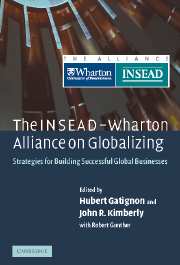Book contents
- Frontmatter
- Contents
- List of figures
- List of tables
- Notes on contributors
- Foreword
- Acknowledgments
- 1 Globalization and its challenges
- Part I Leading the global organization
- 2 The changing international corporate governance landscape
- 3 Corporate governance and leadership in a globalizing equity market
- 4 Leadership in a global organization: a cross-cultural perspective
- 5 The globalization of business education
- Part II Global market participation
- Part III Managing risk and uncertainty
- Part IV Implications and conclusions
- Author index
- Subject index
5 - The globalization of business education
from Part I - Leading the global organization
Published online by Cambridge University Press: 14 January 2010
- Frontmatter
- Contents
- List of figures
- List of tables
- Notes on contributors
- Foreword
- Acknowledgments
- 1 Globalization and its challenges
- Part I Leading the global organization
- 2 The changing international corporate governance landscape
- 3 Corporate governance and leadership in a globalizing equity market
- 4 Leadership in a global organization: a cross-cultural perspective
- 5 The globalization of business education
- Part II Global market participation
- Part III Managing risk and uncertainty
- Part IV Implications and conclusions
- Author index
- Subject index
Summary
What does it mean to be a global business school? As business has become increasingly international, the demands of preparing business leaders for success in a global environment have forced leading business schools to reexamine their programs and structure. Schools have used a variety of strategies to raise the bar on internationalization. They have established programs and campuses around the world, brought in international students and faculty, and reshaped their organizations through alliances and joint ventures. The authors review four different models business schools have used to “internationalize” their programs: the import model, the export model, the partnership model, and the network model. They examine some of the key challenges of the process and strategies for success for each model. Finally, they explore some of the key leadership challenges for global business schools. While the focus is on education and research, the solutions of business schools to their global challenges offer insights for corporate managers on the development of global learning communities and managing international networks of knowledge workers.
Business schools are becoming more global. Our students and faculty are drawn increasingly from around the world. The content of what we offer to participants in our courses, be they full-time graduate students or executives, is gradually adapted to the needs of operating in an international environment. As shown in Table 5.1, of the top twenty schools listed in a recent Financial Times ranking, all drew at least a quarter of their students from outside their domestic markets, and with one exception, at least a tenth of their faculty members from abroad.
- Type
- Chapter
- Information
- The INSEAD-Wharton Alliance on GlobalizingStrategies for Building Successful Global Businesses, pp. 104 - 128Publisher: Cambridge University PressPrint publication year: 2004
- 15
- Cited by



